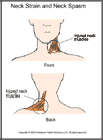
Neck Strain
What is neck strain?
A strain is a tear of a muscle or tendon. Your neck is surrounded by small muscles, which run close to the vertebrae, and larger muscles, which make up the visible muscles of the neck.
How does it occur?
Neck strains most often occur when the head and neck are forcibly moved, such as in a whiplash injury or from contact in sports.
What are the symptoms?
You have pain in your neck. When the neck muscles go into spasm you feel hard, tight muscles in your neck that are very tender to the touch. You have pain when you move your head to either side or when you try to move your head up or down. The spasming muscles can cause headaches.
How is it diagnosed?
Your health care provider will examine your neck. Your neck muscles will be tender and tight. You may have pain over the bones in your neck. Your health care provider may order x-rays to make sure the vertebrae are not injured.
How is it treated?
Right after the injury you should place an ice pack on your neck for 20 to 30 minutes every 3 or 4 hours for 2 to 3 days or until the pain goes away.
Your health care provider may prescribe an anti-inflammatory medication and a neck collar to support your neck and prevent further injury.
If you still have neck pain several days after the injury and after using ice, your health care provider may recommend using moist heat on your neck. You can buy a moist-heat pad or make your own by soaking towels in hot water. You should apply moist heat to your neck for 20 to 30 minutes every 3 or 4 hours until the pain goes away. You may find that it helps to alternate putting heat and ice on your neck.
How long will the effects last?
Most people recover from neck strains in a few days to a few weeks, but some people take longer to get better.
When can I return to my sport or activity?
The goal of rehabilitation is to return you to your sport or activity as soon as is safely possible. If you return too soon you may worsen your injury, which could lead to permanent damage. Everyone recovers from injury at a different rate. Return to your sport or activity will be determined by how soon your neck recovers, not by how many days or weeks it has been since your injury occurred. In general, the longer you have symptoms before you start treatment, the longer it will take to get better.
If you participate in contact sports, it is important to rehabilitate your neck and shoulders before going back to competition. You must have full range of motion of your neck. This means you must be able to:
- turn your head fully to look over both shoulders
- extend your head backward as far as possible
- flex your neck forward until your chin touches your chest
- move your head in each direction so that your ear touches your shoulder.
If any of these actions cause burning in your neck or shoulder, or pain or spasm in your neck or shoulder muscles, you are not yet able to return.
How can I prevent neck strain?
Neck strain is best prevented by having strong and supple neck muscles. If you have a job that requires you to be in one position all day (for example, work at a computer all day), it is very important to take breaks and relax your neck muscles.
In many cases an injury to the neck occurs during an accident that is not preventable.

